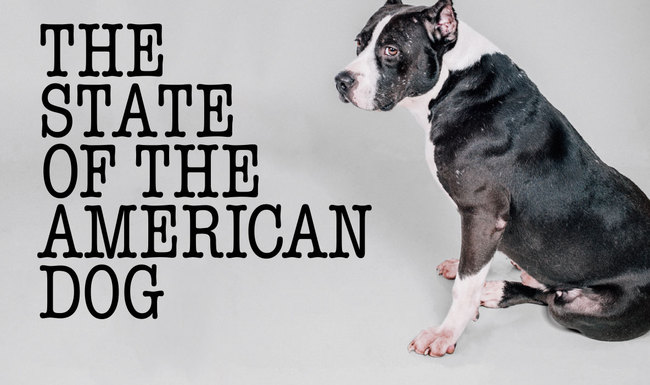
When you’re learning the ropes in journalism, specifically what traits qualify a story as worth reporting, an oft-cited illustrative tenet is that if a dog bites a man, that’s not news. But if a man bites a dog, well, that is news.
The realm of pit bulls over the last decade or so has impelled this journalistic operating principle to reverse course in a more literal sense, both reflecting and exacerbating the public perception problem that has plagued these animals. (And, the sensationalized, often inaccurate reporting on pit bill attacks has, arguably, helped erode the media’s credibility in this area, though that’s mostly another column for another time.)
Media coverage in recent years has become surprisingly rife with dog bites man stories, except they’re almost invariably reported as “Pit Bull Bites Man.” Or, “Pit Bull Bites Woman.” Or, especially, “Pit Bull Bites Child.”
Why this wholesale repudiation of the credo taught since time immemorial in Journalism 101? And, far more intriguingly, why are the culprits blared in those headlines often not necessarily pit bulls?
These rest among the panoply of issues rolled into “The State of The American Dog,” an extended examination of the plight and perception of the pit bull published in the August issue of Esquire, written by veteran journalist Tom Junod,

Tom Junod
An Esquire writer-at-large who has twice won the National Magazine Award (considered the highest honor in the magazine biz), Junod drew on a wealth of reporting and research—and more than a little personal experience—to fashion what may stand as the definitive look at today’s complex, perplexing, sometimes-contradictory, often-emotionally charged province of pit bulls.
Among the things Junod makes clear about the pit bull province: it doesn’t countenance clear-cut views or interpretations, there’s nothing black-or-white here—this may involve 150 shades of grey.
Junod’s intricate opus is partly propelled by his family’s lengthy experience with pit bulls: They had one, Carson, for 11 years, and then some months after he passed away, they adopted their current one, Dexter.
So, he has both direct and extended history with these dogs, and therefore has been conversant with the issues that constitute the core of the pit bulls’ complicated saga for many years. So I began my Talking Animals interview with him August 6 wondering if there had been a particular catalyst that precipitated writing the article now?
“Yeah, a lot of the pieces that I write for the magazine have their origin in personal matters,” Junod replied.”
“Even if that’s not always obvious to the reader, it’s sort of obvious to me, I guess. And with this piece, the catalyst was really that our pit bull of 11 years, Carson, died in September, and my editor asked me if I wanted to write something about him at the time.
“And I said, ‘Yeah, I would,’ but I didn’t want to write another story about the pain of having a dog dying, which I had already written for Esquire. Back in 2002, I wrote a story called Marco Died, about the death of our dog, Marco.
“So I didn’t want to do that again. I wanted to do a larger take on pit bulls in general—the fact that there are so many of them, and that they’re still, in so many ways, not accepted. And what that means.
“And I was sort of plotting and brewing that and then we got Dexter. Four days after we got Dexter, he was attacked by a cocker spaniel that was extremely dog aggressive, and had gotten loose, had gotten out of his house.
“And the consequences of that attack, to me, to Dexter and to the cocker spaniel, made me realize that this is really not something to be trifled with. That it was something that I had to process. So I had to process it through writing a piece, which is what I do.”

If you may be surmising that a longtime pit bull guy would write a piece with a decidedly pro-pit bull slant, you may find it surprising to learn how far off your surmising is.
I mean, you don’t become an in-house writer at Esquire or win a pair of National Magazine Awards by practicing that sort of journalism. And Junod’s article certainly does not play as anti pit bull, of course.
But the reporting runs deep and wide, and it’s resolutely honest, depicting with unblinking candor the Dexter attack he just mentioned while he and his daughter were walking the dog: Yes, the cocker spaniel initiated the fight, but Junod describes in harrowing detail in the story his efforts to prevent Dexter from making the incident horrific.
“It didn’t go well for the cocker spaniel,” he recalled. “I mean, Dexter turned around and grabbed the cocker spaniel. And it became a damaging incident to the cocker spaniel and, to a degree, to my daughter and me.
“We could not get Dexter off him for a good two minutes, and so my daughter was somewhat traumatized by that, and so was I, because I realized—and it’s what I say in the piece—that the margin for error with a pit bull is less.
“We had our dog, Carson, for 11 years. He had been involved in a fighting ring in some way. We were told he was a bait dog. I don’t know if that was true. But he was covered with scars, he had broken teeth, and a burn down his back, all this sort of stuff. But for 11 years, that dog did not hurt a living soul, or even come close to fighting back when he was attacked. He was attacked several times by several other dogs in other fights that I had to break up.
“All of a sudden our dog Dexter is being attacked, responds in kind, responds hard in a way that brought the reality of the breed home to me.”
https://www.youtube.com/watch?v=67QBA3tnzI4
‘Pitbulls are Awesome: A Compilation’ posted at YouTube by Petsami
Right there, Junod offers a glimpse of the vast grey area that his article roams: The folks who contend that pit bulls are not dangerous and can be very sweet dogs are right—and wrong. And the folks who maintain that pit bulls are dangerous and too risky to be around are right—and wrong.
Moreover, Junod’s article illustrates that the situation is a good deal more nuanced even than that. For starters, partly owing to all the “Pit Bull Bites [Insert Word Here]” stories and the ensuing hysteria they’ve spawned in some quarters, many municipalities and other locales have passed Breed Specific Legislation (BSL) outlawing pit bulls.
These ordinances mean that in areas where BSL has been implemented you cannot live there if you have a pit bull. Or, to phrase it another way, a pit bull cannot live with you there.
Sometimes facets of BSL can reach absurd proportions, not least when it comes to enforcement. This point dovetails with what may constitute the $64,000 question (or one of ‘em) raised in Junod’s article:
What, exactly, is a pit bull?
One measure of how difficult that question is to answer centers around the situation in Miami-Dade County, where they have Breed Specific Legislation against pit bulls, yet struggle mightily to determine what, in fact, that breed is.
A promotional/information video from Project for Awesome (Angel City Pitbulls) posted at YouTube by Dana Boe, who is donating a penny to Angel City Pit Bulls for every comment and like. Angel City Pit Bulls is a 501 3c non-profit dedicated to building a better future for pit bulls.
Junod reports that the animal-services investigator, Luis Salgado, whose job includes enforcing the Miami ban is thwarted on various levels, including the most scientific: “there is no reliable DNA testing for that breed. DNA is useless” Junod quotes him as saying, explaining that Salgado instead uses a 47-point checklist of physical characteristics, and adding that Salgado explains that “Any dog that substantially conforms to the characteristics of a pit bull is considered a pit bull.”
(As a visually arresting way to arrive at further understanding of just how varied the appearances of pit bulls can be, check out the gallery of gorgeous dog pictures, taken by photographer Michael Friberg, accompanying Junod’s article.)
In my Talking Animals conversation with Junod, I mention that the 47-point checklist seems labyrinthine and nutty, and that I’m not really sure the results yield anything of value.
“I’m not sure, either,” he said, leading into an exchange about the severe challenge of identifying pits.
This exchange included an anecdote I mentioned about a power point presentation I had attended at an animal conference, where folks were asked to determine amidst several dog whose photos which projected on a big screen which ones were pit bulls; among other startling results, it turned out that a dog who looked like my yellow Lab Daisy had more pit in her than some of the canines that looked more classically pit.
“The complication is that if one of those mixed dogs bites, it becomes [classified as] a pit bull,” Junod observed, returning to the racial-like bias against these dogs that constitutes another major theme of his piece.
“And that’s really when you get to the crux of it. If a pit Lab mix bites, it becomes a pit bull–it doesn’t become a Lab.”
As another aspect of the bias against pits, I suggest, statistics tend to skew toward chalking up another negative mark in the pit bull column. For many, that’s the default position.
“Yeah, listen, everybody knows that by their nature, dogs are a managed risk,” he responded. “The argument is that pit bulls bring a much higher risk to the game. But that does not circumvent the obligation to manage that higher risk. That is really the heart of the matter.”
“The State of The American Dog” provides another potent, and profoundly grim, reflection of this bias when Junod examines the euthanasia data at animal shelters.
“Every year,” Junod writes, “American shelters have to kill about 1.2 million dogs. But both pro and anti-pit-bull organizations estimate that of these, anywhere from 800,000 to nearly one million are pit bulls. We kill from 2,000 to 3,000 pit bulls a day.”
Staggering statistics, to be sure, and ones that really encapsulate in a tangible way just how extreme and fundamental the anti-pit bull bias truly is, how stigmatized these animals have become—particularly when you consider, as we’ve learned, that a sizable percentage of those dogs aren’t actually pit bulls.

But even when it comes to dogs that are inarguably pit bulls, like his Dexter, Junod—in the article and in our conversation—doesn’t pretend for a moment that the situation is clear-cut, much less easy.
Toward the end of the piece, he chronicles another incident where Dexter attacked a neighbor’s shih tzu while his daughter, accompanied by his wife, were going door-to-door, to raise money for—irony alert—a pit bull advocacy group called Stubby Dog.
The fight was a perfect storm of human error and dog behavior, and Junod hardly whitewashes the description (“There’s a lot of mythology, and there’s a lot of BS that I think comes up on both sides of the pit bull divide,” he said in our interview. “My story tried to get around some of that by being honest. I try to be as honest as I can, about my own experiences and my own dog”), noting that Dexter bit and broke the shih tzu’s leg.
Traumatic as the experience was for all involved, it was also illuminating for the Junod family. “Ever since then, we have had to decide to really keep Dexter under control at all times.
“And it was interesting because I called Stubby Dog after that, and they basically said that in that condition, Dexter was certainly not the only dog in the world that would’ve gotten into a fight in that circumstance. It’s that the ingredients in that situation were kind of tailor made for dogs battling. But once again, the margin of error, given the power of the dog, is much smaller.”
Still, in the wake of this attack—the second one Dexter was involved in the few months since the Junods adopted him–there was more than a little contemplation in their household.
“We decided Dexter was worth saving,” Junod explained. “Obviously, returning Dexter to the shelter at that point would lead to Dexter’s demise—there was no doubt about that. Dexter’s a rescue dog, but we definitely had to rescue him again, in a certain way.”
Click here to go to the Talking Animals interview with Tom Junod

About the author: Duncan Strauss is the producer-host of “Talking Animals,” which he launched at KUCI in California in 2003, combining his passions for animals, radio, journalism, music and comedy. The show has aired since late 2005 on Tampa’s WMNF. Strauss lives in Jupiter Farms, FL, with his family, including four cats, two horses and one dog. He spends each day talking to those animals, and maintains they talk right back to him, an as yet unverified claim.

